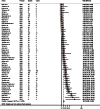Prevalence of complications in neuromuscular scoliosis surgery: a literature meta-analysis from the past 15 years
- PMID: 23085815
- PMCID: PMC3676557
- DOI: 10.1007/s00586-012-2542-2
Prevalence of complications in neuromuscular scoliosis surgery: a literature meta-analysis from the past 15 years
Abstract
Purpose: Our objectives were primarily to review the published literature on complications in neuromuscular scoliosis (NMS) surgery and secondarily, by means of a meta-analysis, to determine the overall pooled rates (PR) of various complications associated with NMS surgery.
Methods: PubMed and Embase databases were searched for studies reporting the outcomes and complications of NMS surgery, published from 1997 to May 2011. We focused on NMS as defined by the Scoliosis Research Society's classification. We measured the pooled estimate of the overall complication rates (PR) using a random effects meta-analytic model. This model considers both intra- and inter-study variation in calculating PR.
Results: Systematic review and meta-analysis were performed for 68 cohort and case-control studies with a total of 15,218 NMS patients. Pulmonary complications were the most reported (PR = 22.71 %) followed by implant complications (PR = 12.51 %), infections (PR = 10.91 %), neurological complications (PR = 3.01 %) and pseudoarthrosis (PR = 1.88 %). Revision, removal and extension of implant had highest PR (7.87 %) followed by malplacement of the pedicle screws (4.81 %). Rates of individual studies have moderate to high variability. The studies were heterogeneous in methodology and outcome types, which are plausible explanations for the variability; sensitivity analysis with respect to age at surgery, sample size, publication year and diagnosis could also partly explain this variability. In regard to surgical complications affiliated with various surgical techniques in NMS, the level of evidence of published literature ranges between 2+ to 2-; the subsequent recommendations are level C.
Conclusion: NMS patients have diverse and high complication rates after scoliosis surgery. High PRs of complications warrant more attention from the surgical community. Although the PR of all complications are affected by heterogeneity, they nevertheless provide valuable insights into the impact of methodological settings (sample size), patient characteristics (age at surgery), and continual advances in patient care on complication rates.
Figures
References
-
- Jones KB, Sponseller PD, Shindle MK, McCarthy ML. Longitudinal parental perceptions of spinal fusion for neuromuscular spine deformity in patients with totally involved cerebral palsy. J Pediatric Orthop. 2003;23:143–149. - PubMed
-
- Bridwell KH, Baldus C, Iffrig TM, Lenke LG, Blanke K. Process measures and patient/parent evaluation of surgical management of spinal deformities in patients with progressive flaccid neuromuscular scoliosis (Duchenne’s muscular dystrophy and spinal muscular atrophy) Spine. 1999;24:1300–1309. doi: 10.1097/00007632-199907010-00006. - DOI - PubMed
Publication types
MeSH terms
LinkOut - more resources
Full Text Sources
Medical
Research Materials
Miscellaneous






